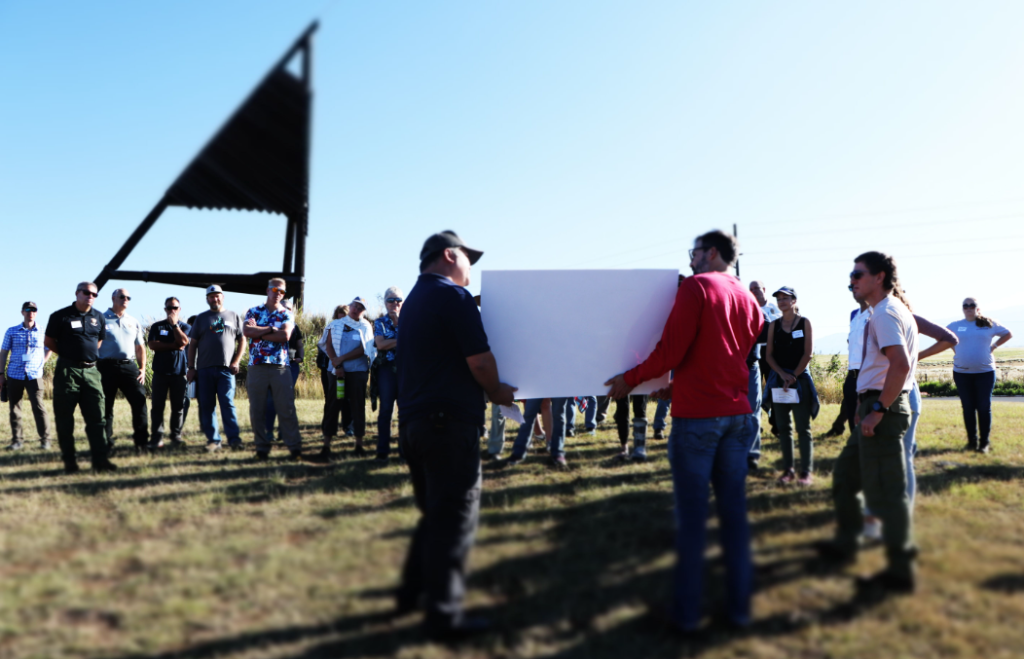12/17/22 – MĀNA ROAD WILDFIRE TOUR PROVIDES TEACHING & LEARNING MOMENTS FOR FIRE MANAGERS
Posted on Dec 19, 2022 in Forestry & Wildlife, News Releases, slider, Wildfire| JOSH GREEN, M.D. GOVERNOR |
SUZANNE D. CASE
CHAIRPERSON |
For Immediate Release: December 17, 2022
MĀNA ROAD WILDFIRE TOUR PROVIDES TEACHING & LEARNING MOMENTS FOR FIRE MANAGERS
To view video please click on photo or view at this link: https://vimeo.com/782098733
(WAIKOLOA, HAWAI‘I) – Fire managers from around the country got an up-close, post-fire tour of the Māna Road fire area on Thursday. They gathered on Hawai‘i Island this week for a state fire chiefs conference, along with meetings of the Western Fire Leadership Council and the Hawai‘i Wildfire Management Organization (HWMO).
Billed as a “Wildfire Learning Exchange Field Tour,” during one stop at the top of Waikoloa Road, under the sundial, participants heard about Hawai‘i-specific wildland fire landscapes, fuels, and fire ecology as they gazed out across hundreds of acres of invasive grasses.
Dr. Clay Trauernicht, a wildland fire expert with the University of Hawai‘i said, “When it comes to wildland fires in Hawai‘i we have three major factors to think about; climate, ignition sources, and fuels.” He and other presenters described how Hawai‘i now has a year-around wildland fire season and noted that while many fires historically have occurred in the dryer, leeward sides of the islands, with climate change fires are igniting more often in windward locations which typically see more precipitation.
In addition to the 2021 Māna Road fire, one of the largest in recent history at 40,000 acres, there was last summer’s 17,000-acre Leilani Fire which burned on the slopes of neighboring Mauna Loa. Cheyenne Perry of the Mauna Kea Watershed Alliance, one of ten public/private/non-profit watershed partnerships in Hawai‘i outlined the multiple ownership of 416,000 acres of partnership lands on Mauna Kea.
“Landholding partners include state and federal agencies, ranches, Kamehameha Schools, and a charitable trust and more than 100 affiliated partners, all dedicated to protecting and enhancing the watershed, and in the case of wildland fires working closely together on prevention and suppression,” Perry noted.
The theme of cooperation was repeated often during the tour. Eric Moller, the Assistant Chief at the Hawai‘i Fire Dept. said, during a second stop off Old Saddle Road, “It’s something very special I’ve seen on this island. To have everybody come together and want to be part of one mission is why we picked laulima as our catchphrase for this week’s fire chiefs conference. It means unity of purpose, coming together, many hands as one. This was demonstrated during the Māna Road fire when a multitude of fire fighting agencies and community volunteers supported the fight against a wildland blaze that Moller described as “amazingly explosive.”
Eric Johnson, Assistant Fire Management Officer, for the U.S. Dept. of the Interior (National Park Service and U.S. Fish and Wildlife Service) detailed the types of weather patterns in Hawai‘i that impact fire ignitions and behavior.
“We have a stratified, layer-cake atmosphere. Trade winds carry moisture-laden clouds to the windward side of Hawai‘i Island, where coastal areas get scattered showers and elevations between 2000-4000 feet get really wet. In those bands you can see sixty to several hundred inches of rain a year. Above 4,000-feet in elevation it gets dryer the higher you go all the way to the top of the mountains at nearly 14,000 feet where rain is a rarity and any precipitation is typically snow,” Johnson explained.
Two DLNR Division of Forestry and Wildlife (DOFAW) presenters talked about the division’s wildfire responsibilities and echoed the concept of mutual aid, provided during fires on the Big Island.
Statewide Fire Protection Forester Mike Walker said DOFAW manages about 26% of the land mass in the main Hawaiian Islands and is first responder for fires on that one-million-acres of land. “We have a militia style firefighting force, which means battling wildfires is not anyone’s primary job. When not commanding wildfires or working on the lines, DOFAW firefighters work as foresters, wildlife biologists, technicians, machine operators, and in many other day jobs,” Walker told the group.
Steve Bergfeld, DOFAW Hawai‘i Island Branch Manager then described the agencies support for the Māna Road firefight. “It wasn’t burning on land under our jurisdiction but that didn’t matter. When there’s a major fire, property lines fall by the wayside, and everyone responds.”
The dashboard tour was organized by HWMO to showcase collaboration, challenges, goals, and lessons learned to improve wildfire prevention and suppression. More than three dozen fire managers from Hawai‘i and the mainland participated.
# # #
RESOURCES
(All images/video courtesy: DLNR)
HD video – Māna Road fire tour (Dec. 15, 2022):
Photographs – Māna Road fire tour (Dec. 15, 2022):
https://www.dropbox.com/scl/fo/71qdvl5fzcww5kscz08ga/h?dl=0&rlkey=fimg9f2qxsd6m64c407yvpl4p
Media Contact:
Dan Dennison
Senior Communications Manager
Hawaii Dept. of Land and Natural Resources
